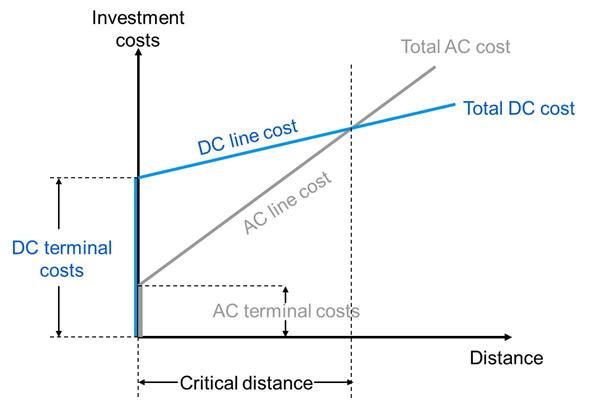Grid Connection
HOWaT will have a similar grid connection, to that of already existing offshore wind turbines. In this section we will analyse the components of transmission line as well as the control system, needed to synchronise both types of generation (wind and tidal).
Transmission Line Components
As seen in the figure below, a HOWaT's farm transmission line will not defer from that of an offshore wind farm. The only aspects that may change within HOWaT farms in the transmission line are the offshore components.

Offshore Components
Inter-array cables
The inter-array cables transport the electricity coming from the hybrid system towards the offshore substation at 33 kV AC in 3 phases.
Offshore AC substation
To provide the same functions as onshore electrical substations: switching devices to connect or disconnect equipment, protection equipment to respond to faults, and transformation to higher voltages for either transmission to shore or feeding an AC/DC converter station. Depending on the project (the generating capacity, the area over which it is located, and the distance to shore), there may be more than one offshore substation for one HOWaT farm.
Export Cable
The export cable would be routed to the Onshore Substation, where it would then be transmitted by onshore cabling to connect to the nearest local distribution network. If there is a use of direct current cabling, there will be a need for an offshore AC/DC converter station to be installed.
Offshore AC/DC converter station
Convert power from AC to High Voltage DC (HVDC) for transmission to shore. They are only needed for projects which deploy HVDC assets. They contain power-electronic converters to convert the power generated by the wind turbines in AC to DC, for transmission to shore. They are likely to be larger than offshore AC substations. Depending on the project generating capacity and design, there may be one offshore converter station, fed by one or more offshore AC substations nearby.
Selection of Export Cable
The type of export cable, whether alternating current (AC) or direct current (DC) transmission cabling, used will be dependant on the sites distance to shore. The transmission losses in AC increase more rapidly than those in DC with the cabling distance. Therefore, even if initially DC cables are costlier, beyond 50-70km [2] cabling distance from shore, it becomes cost effective to use DC transmission.

The high installation costs of DC in comparison to AC, are due to the need of a converter AC/DC offshore station
In our Islay case study, the site chosen is only 8km offshore, so the use of AC will be more suitable.
Combining both Generation Systems
The system has two types of generation, the tidal generator and the offshore wind turbine generator. To combine both generators in one system, the outputs from both generators would need to be synchronised, where the voltages fluctuate at the same frequency and in phase.
The offshore-wind turbines power output of the offshore-wind turbine fluctuates during the day due to changes in wind speed. These fluctuations affect the frequency and voltage. In order to maintain the HOWaT system output power with the required voltage and frequency parameters, it is desirable to keep its output voltage constant even when the wind velocity changes. Therefore an output voltage control system is needed to keep the voltage constant for the cases when the wind velocity is changing. Controlling the turbines can help to extract more energy from the wind and reduce structural loads and fatigue load cycles that can cause component failure. The speed and power of the turbine are controlled by varying the generator torque and the blade pitch angles based on measurement of the generator shaft speed [4].
- TenneT (2012). Grid Connection Regulations
- Joe Corbett (2011). HVDC vs. HVAC cables for offshore wind Available online
- ABB (2015). Economical and Environmental Advantages of HVDC Available online
- Zero-Carbon Energy (Kyoto 2009). Proceedings of the First International Symposium of Global COE Program “Energy Science in the Age of Global Warming—Toward CO2 Zero-emission Energy System”
- The Crown Estate (2013). Transmission infrastructure for Offshore Generation